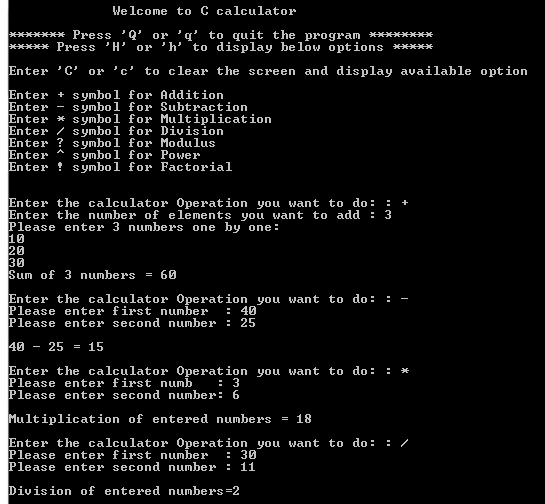

Relational operators are heavily used in decision-making and performing loop operations. If the given relation is true, it will return 1 and if the relation is false, then it will return 0. It checks the relationship between two operands. Relational operators are specifically used to compare two quantities or values in a program. The below example explains the working of assignment operator. Used for bitwise inclusive OR and assignment operator. Used for bitwise exclusive OR and assignment operator. Used for bitwise AND assignment operator. Used for right shift AND assignment operator. Takes modulus using the values of the two operands and assigns the result to the left operand. Multiplies the value of the right operand with the value of the left operand and assigns the result to the left operand.ĭivides the value of the left operand with the value of the right operand and assigns the result to the left operand. Subtracts the value of the right operand from the value of the left operand and assigns the result to the left operand. Used to assign the values from right side of the operands to left side of the operand.Ĭ = A + B will assign the value of A + B to C.Īdds the value of the right operand to the value of the left operand and assigns the result to the left operand. The table below lists all the assignment operators supported by the C language: Operator The most common assignment operator is =.Ĭ language has a collection of shorthand assignment operators that can be used for C programming. This operator plays a crucial role in assigning the values to any variable. Assignment operators are applied to assign the result of an expression to a variable. Note that these two operators can also be used as postfixes like a++ and a- when required.Īn assignment operator is mainly responsible for assigning a value to a variable in a program.
C PROGRAM FOR ARITHMETIC CODING EXAMPLE CODE
In the above code example, the increment and decrement operators ++ and - have been used as prefixes. Examples of increment and decrement operators Here is an example demonstrating the working of increment and decrement operator:

This decrement operator decreases the integer value by 1. This increment operator increases the integer value by 1. Whereas, when it is used as a post-fix, it first assigns the value to the variable on the left i.e., it first returns the original value, and then the operand is incremented by 1. If we use the operator as a pre-fix, it adds 1 to the operand, and the result is assigned to the variable on the left. There is a slight distinction between ++ or −− when written before or after any operand. For example, ++x and x++ means x=x+1 or -x and x−− means x=x-1. These two operators are unary operators, which means they can only operate on a single operand. Increment and Decrement Operators are very useful operators that are generally used to minimize the calculation. It can change the value of an operand (constant or variable) by 1. Increment/Decrement Operator With ExampleĬ programming has basically two operators which can increment ++ and decrement - the value of a variable. When either one of the operands is a floating-point number Suppose a = 7.0, b = 2.0, c = 5, and d = 3, the output will be: If we want the result of our division operator in decimal values, then either one of the operands should be a floating-point number. When a=7 is divided by b=5, the remainder is 2. Using modulo operator (%), you can compute the remainder of any integer. So, the compiler neglects the term after the decimal point and shows 2 instead of 2.25 as the output of the program.Ī modulo operator can only be used with integers. Hence, the output should also be an integer. The reason behind this is that both the variables a and b are integers. However, the output is 1 in the above program. The operators shown in the program are +, -, and * that computes addition, subtraction, and multiplication respectively. Printf("Remainder when a is divided by b = %d \n",c) Let’s look at an example of arithmetic operations in C below assuming variable a holds 7 and variable b holds 5. This operator gives the remainder of an integer after division It is responsible for dividing numerator by the denomerator It subtracts second operand from the first The following table provided below shows all the arithmetic operators supported by the C language for performing arithmetic operators. It performs all the operations on numerical values (constants and variables). Arithmetic Operators are the operators which are used to perform mathematical calculations like addition (+), subtraction (-), multiplication (*), division (/), and modulus (%).


 0 kommentar(er)
0 kommentar(er)
